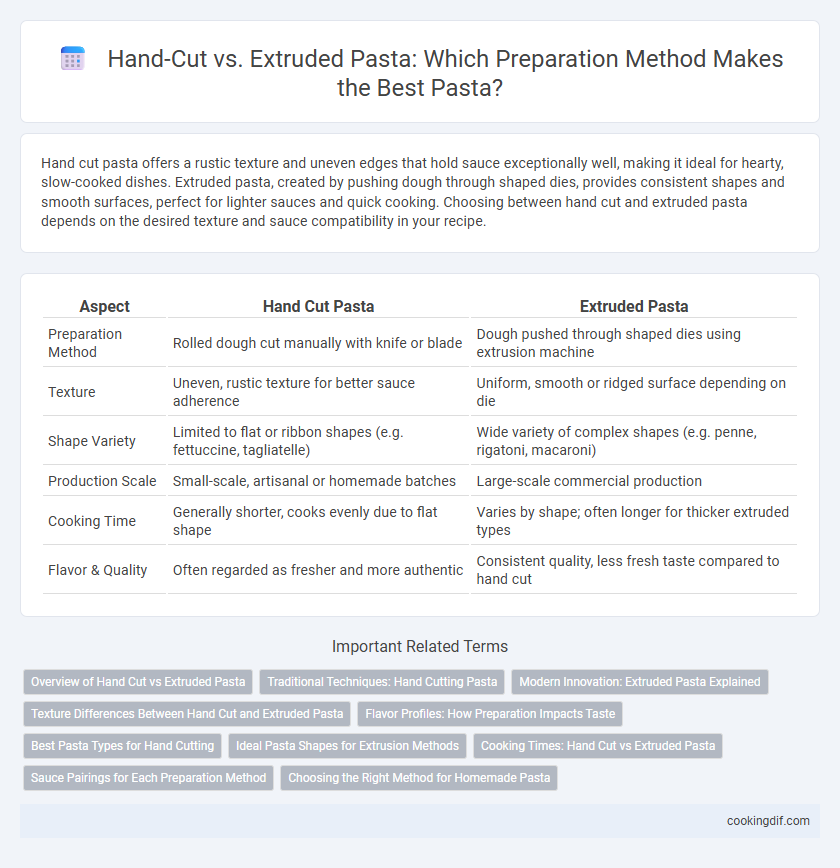Hand cut pasta offers a rustic texture and uneven edges that hold sauce exceptionally well, making it ideal for hearty, slow-cooked dishes. Extruded pasta, created by pushing dough through shaped dies, provides consistent shapes and smooth surfaces, perfect for lighter sauces and quick cooking. Choosing between hand cut and extruded pasta depends on the desired texture and sauce compatibility in your recipe.
Table of Comparison
| Aspect | Hand Cut Pasta | Extruded Pasta |
|---|---|---|
| Preparation Method | Rolled dough cut manually with knife or blade | Dough pushed through shaped dies using extrusion machine |
| Texture | Uneven, rustic texture for better sauce adherence | Uniform, smooth or ridged surface depending on die |
| Shape Variety | Limited to flat or ribbon shapes (e.g. fettuccine, tagliatelle) | Wide variety of complex shapes (e.g. penne, rigatoni, macaroni) |
| Production Scale | Small-scale, artisanal or homemade batches | Large-scale commercial production |
| Cooking Time | Generally shorter, cooks evenly due to flat shape | Varies by shape; often longer for thicker extruded types |
| Flavor & Quality | Often regarded as fresher and more authentic | Consistent quality, less fresh taste compared to hand cut |
Overview of Hand Cut vs Extruded Pasta
Hand-cut pasta is traditionally made by rolling out dough and slicing it into shapes like fettuccine or pappardelle, offering a rustic texture that holds thicker sauces well. Extruded pasta, produced by forcing dough through molds, creates uniform shapes such as penne or rigatoni, ideal for capturing lighter sauces and baking dishes. Each method influences pasta's surface texture and sauce adherence, impacting the overall dining experience.
Traditional Techniques: Hand Cutting Pasta
Hand-cut pasta showcases traditional Italian craftsmanship through techniques involving rolling dough into sheets and slicing with knives or specialized cutters, resulting in varied textures that enhance sauce absorption. Unlike extruded pasta, which is shaped by forcing dough through dies, hand-cut pasta offers artisanal irregularities and a tender bite ideal for fresh, simple sauces. This method emphasizes control over thickness and shape, contributing to authentic, rustic pasta dishes celebrated in regional Italian cuisine.
Modern Innovation: Extruded Pasta Explained
Extruded pasta is created by forcing dough through specialized dies, allowing consistent shapes and textures ideal for capturing sauces and enhancing mouthfeel. Unlike hand cut pasta, which varies in thickness and requires skillful manual preparation, extruded pasta benefits from precision and scalability in modern production. Innovations in extrusion technology enable diverse pasta forms, improved cooking performance, and streamlined mass manufacturing.
Texture Differences Between Hand Cut and Extruded Pasta
Hand-cut pasta exhibits a rougher, more porous texture that effectively holds chunky sauces, enhancing flavor absorption during cooking. Extruded pasta has a denser, smoother surface created by extrusion through dies, resulting in a firmer bite and consistent shape ideal for lighter, oil-based sauces. The choice between hand-cut and extruded pasta directly influences the mouthfeel and sauce adherence, impacting the overall dining experience.
Flavor Profiles: How Preparation Impacts Taste
Hand-cut pasta often features irregular shapes and thicker edges, allowing it to hold richer, more complex sauces and enhancing the overall flavor intensity. Extruded pasta typically has a smoother surface and uniform shape, which facilitates even cooking and a consistent texture that highlights delicate, lighter sauces. The preparation method influences the pasta's ability to absorb and complement different flavor profiles, with hand-cut varieties offering a more rustic, artisanal taste experience.
Best Pasta Types for Hand Cutting
Hand-cut pasta, with its rough texture and uneven edges, perfectly absorbs rich, chunky sauces, making it ideal for varieties like pappardelle and fettuccine. In contrast, extruded pasta shapes such as penne and rigatoni are produced by forcing dough through molds, resulting in a consistent texture suited for baked dishes and smooth sauces. Choosing hand-cut pasta enhances the flavor adherence, especially with rustic, hearty preparations.
Ideal Pasta Shapes for Extrusion Methods
Extruded pasta is ideal for shapes with ridges, grooves, or tubular forms such as penne, rigatoni, and fusilli, which enhance sauce adherence and texture. The extrusion process forces dough through specially shaped dies, allowing consistent thickness and intricate designs that hold up well during cooking. These shapes are preferred for hearty sauces and baked dishes, offering optimal flavor absorption compared to hand-cut pasta, which typically yields simpler, flat forms like fettuccine or pappardelle.
Cooking Times: Hand Cut vs Extruded Pasta
Hand cut pasta typically requires shorter cooking times, often around 2 to 4 minutes, due to its slightly thicker and uneven texture that allows water to penetrate quickly. In contrast, extruded pasta, shaped by pushing dough through molds, generally cooks longer, ranging from 8 to 12 minutes, based on its thickness and density. Understanding these differences ensures optimal cooking and perfect pasta texture for dishes.
Sauce Pairings for Each Preparation Method
Hand-cut pasta, such as pappardelle or tagliatelle, features a rough texture that absorbs thick, chunky sauces like ragu or Bolognese, enhancing flavor adherence and mouthfeel. Extruded pasta, including penne and rigatoni, has ridges and tubular shapes designed to capture robust and creamy sauces like arrabbiata or Alfredo, providing well-balanced sauce distribution. Choosing the right pasta shape based on preparation method optimizes the sauce pairing experience, elevating the dish's overall taste and texture.
Choosing the Right Method for Homemade Pasta
Hand cut pasta offers a rustic texture and irregular shapes that enhance sauce adherence, ideal for simple preparations like tagliatelle or pappardelle. Extruded pasta provides uniform shapes such as rigatoni or penne, suitable for recipes requiring consistent cooking times and sturdy forms to hold thicker sauces. Selecting the right method depends on desired texture, sauce compatibility, and presentation style, ensuring optimal homemade pasta results.
Hand cut vs extruded pasta for preparation method Infographic

 cookingdif.com
cookingdif.com